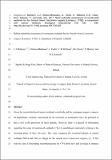| dc.contributor.author | Mulkeen, Collette J. | |
| dc.contributor.author | Gibson-Brabazon, S. | |
| dc.contributor.author | Carlin, C.. | |
| dc.contributor.author | Williams, C.D. | |
| dc.contributor.author | Healy, Mark G. | |
| dc.contributor.author | Mackey, P. | |
| dc.contributor.author | Gormally, Michael J. | |
| dc.date.accessioned | 2017-06-30T08:56:23Z | |
| dc.date.issued | 2017-06-22 | |
| dc.identifier.citation | Mulkeen, C. J., Gibson-Brabazon, S., Carlin, C., Williams, C. D., Healy, M. G., Mackey, P., & Gormally, M. J. (2017). Habitat suitability assessment of constructed wetlands for the smooth newt (Lissotriton vulgaris [Linnaeus, 1758]): A comparison with natural wetlands. Ecological Engineering, 106, Part A, 532-540. doi: https://doi.org/10.1016/j.ecoleng.2017.06.005 | en_IE |
| dc.identifier.issn | 0925-8574 | |
| dc.identifier.uri | http://hdl.handle.net/10379/6626 | |
| dc.description.abstract | Given the current decline of natural wetlands worldwide and the consequent negative impacts on amphibians, wetlands constructed for the treatment of wastewaters have the potential to play a role in the protection of these animals. However, there is a paucity of information regarding the value of constructed wetlands (CWs) to amphibians, particularly relating to the terrestrial phase of their life-cycle. This study compares the terrestrial habitats of natural wetlands (NWs) and CWs as refuges for the smooth newt (Lissotriton vulgaris, [L., 1758]) with the aim of developing recommendations for CWs (both new and existing) to enhance their usefulness as newt friendly habitats. Terrestrial habitats surrounding NWs and CWs were mapped using ArcGIS. Potential barriers to newt movement in addition to the presence of features such as wood or stone which could act as potential newt refuges were also mapped. Natural wetlands had significantly more terrestrial habitat types than CWs and while woodlands at both wetland types were most likely to contain features of benefit to newts, terrestrial habitats of NWs contained more features compared to those of CWs. The application of a Habitat Suitability Index, which assesses the likelihood of the presence of newts, resulted in seven of eight NWs compared to only two of eight CWs receiving good scores, the lower scores for CWs being due primarily to the presence of a barrier to newt movement. Recommendations for enhancing the design and management of CWs for smooth newts include less intensive ground maintenance, reduction of barriers to newt movement, judicious planting of suitable trees or shrubs and the provision of additional refuges such as wood or stone. | en_IE |
| dc.description.sponsorship | The authors acknowledge funding from the Irish Environmental Protection Agency (EPA) (Project number 2013-B-PhD-12). | en_IE |
| dc.format | application/pdf | en_IE |
| dc.language.iso | en | en_IE |
| dc.publisher | Elsevier | en_IE |
| dc.relation.ispartof | Ecological Engineering | en |
| dc.rights | Attribution-NonCommercial-NoDerivs 3.0 Ireland | |
| dc.rights.uri | https://creativecommons.org/licenses/by-nc-nd/3.0/ie/ | |
| dc.subject | Smooth newt | en_IE |
| dc.subject | Habitat Suitability Index | en_IE |
| dc.subject | Constructed wetlands | en_IE |
| dc.subject | Natural wetlands | en_IE |
| dc.title | Habit suitability assessment of constructed wetlands for the Smooth Newt (Lissotriton vulgaris [Linnaeus, 1758]): a comparison with natural wetlands | en_IE |
| dc.type | Article | en_IE |
| dc.date.updated | 2017-06-26T07:45:44Z | |
| dc.identifier.doi | 10.1016/j.ecoleng.2017.06.005 | |
| dc.local.publishedsource | https://doi.org/10.1016/j.ecoleng.2017.06.005 | en_IE |
| dc.description.peer-reviewed | peer-reviewed | |
| dc.contributor.funder | |~|1267871|~| | |
| dc.description.embargo | 2019-06-22 | |
| dc.internal.rssid | 12726323 | |
| dc.local.contact | Mark Healy, Room Eng-1038, Civil Engineering, Col Of Engineering & Informatics, Nui Galway. 5364 Email: mark.healy@nuigalway.ie | |
| dc.local.copyrightchecked | No | |
| dc.local.version | ACCEPTED | |
| nui.item.downloads | 265 | |


